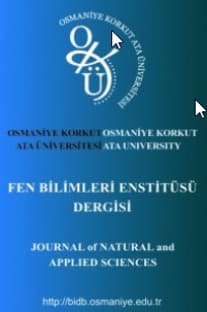Süt Sığırı Rasyonunun İn Vitro Ruminal Gaz Üretimi, Metan Salınımı, Organik Asit ve Protozoa Sayısı Üzerine Aquilaria agallocha Roxb.Uçucu Yağının Etkisi
The Effects of Aquilaria agallocha Roxb. Volatile Oil on In Vitro Ruminal Gas Production, Methane Emission, Volatile Fatty Acide Amountsand Protozoa Counts of Total Mixed Ration of Dairy Cattle
___
- Beauchemin KA., Ungerfeld EM., Eckard RJ., Wang M. Review: fifty years of research on rumen methanogenesis: lessons learned and future challenges for mitigation. Animal 2020; 14(1): 2-16.
- Blümmel M., Makkar HPS., Becker K. In vitro gas production: A technique revisited. J Anim Phys Anim Nutr 1997; 77(1): 24-34.
- Dehority BA. Evaluation of subsampling and fixation procedures used for counting rumen protozoa. Appl Environ Microbiol 1984; 48: 182-185.
- Cobellis G., Trabalza MM., Marcotullio MC., Yu Z. Evaluation of different essential oils in modulating methane and ammonia production, rumen fermentation, and rumen bacteria in vitro. Anim Feed Sci Technology 2016; 215: 25-36.
- Ersahince C., Kara K. Nutrient composition and in vitro digestion parameters of Jerusalem artichoke (Helianthus tuberosus L.) herbage at different maturity stages in horse and ruminant. Journal of Animal and Feed Sciences 2017; 26(3): 213-225.
- Garcia F., Colombatto D., Brunetti MA., Martínez MJ., Moren MV., Scorcione TM., Martínez FJ. The reduction of methane production in the in vitro ruminal fermentation of different substrates is linked with the chemical composition of the essential oil. Animals 2020; 10(5): 786.
- Gerber P., Hristov AN., Henderson B., Makkar H., Oh J., Lee C., Meinen R., Montes F., Ott T., Firkins J., A Rotz., Dell C., Adesogan AT., Yang WZ, Tricarico JM., Kebreab E., Waghorn G., Dijkstra J., Oosting S. Technical options for the mitigation of direct methane and nitrous oxide emissions from livestock: A review. Animal 2013; 2(2): 220-234.
- Ulger I., Kamalak A., Kurt O., Kaya E., Guven I. Comparación de la composición química y el potencial anti-metanogénico de las hojas de Liquidambar orientalis con hojas de Laurus nobilis y Eucalyptus globulus utilizando la técnica de producción de gas in vitro. Ciencia Invest Agraria 2017; 44(1): 75-82.
- Joch M., Cermak L., Hakl J., Hucko B., Duskova D., Marounek M. In vitro screening of essential oil active compounds for manipulation of rumen fermentation and methane mitigation. AsianAustralasian Journal of Animal Sciences 2016: 29(7): 952.
- Kara K. Nutrient matter, fatty acids, in vitro gas production and digestion of herbage and silage quality of yellow sweet clover (Melilotus officinalis L.) at different phenological stages. J Anim Feed Sci 2021; 30(2): 128-140.
- Makkar HPS., Blümmel M., Becker K. In vitro rumen apparent and true digestibilities of tannin-rich forages. Anim Feed Sci Technology 1997; 67: 245-251.
- Mandal GP., Roy A., Patra AK. Effects of plant extracts rich in tannins, saponins and essential oils on rumen fermentation and conjugated linoleic acid conentrations in vitro. Indian J Anim 2016; 55: 49-60.
- Menke KH., Raab L., Salewski A., Steingass H., Fritz D., Schneider W. The estimation of the digestibility and metabolizable energy content of ruminant feeding stuffs from the gas production when they are incubated with rumen liquor in vitro. The J Agricultural Sci 1979; 93(1): 217-222.
- Onel SE., Taylan A., Kanber K., Aksu DS. The effects of laurel volatile oil (Laurusnobilis L.) on in vitro ruminal gas production of methane emission, organic acids and protozoa counts alfalfa herbage. Erciyes Üniversitesi Veteriner Fakültesi Dergisi 2020; 17(3): 283-289.
- Patra AK., Yu Z. Effects of essential oils on methane production and fermentation by, and abundance and diversity of, rumen microbial populations. Appl Environ Microbiol 2012; 78(12): 4271-4280.
- Schultz MM., Neser FW., Makgahlela ML. A balanced perspective on the importance of extensive ruminant production for human nutrition and livelihoods and its contribution to greenhouse gas emissions. South African Journal of Science 2020; 116(9-10): 1-3.
- Tural S., Turhan S. Antimicrobial and antioxidant properties of thyme (Thymus vulgaris L.), rosemary (Rosmarinus officinalis L.) and laurel (Lauris nobilis L.) essential oils and their mixtures. Gıda J of Food 2017; 42(5): 588-596.
- Zhou R., Wu J., Lang X., Liu L., Casper DP., Wang C., Wei S. Effects of oregano essential oil on in vitro ruminal fermentation, methane production, and ruminal microbial community. J Dairy Sci 2020; 103(3): 2303-2314.
- ISSN: 2687-3729
- Yayın Aralığı: Yılda 3 Sayı
- Başlangıç: 2017
- Yayıncı: Osmaniye Korkut Ata Üniversitesi
Simetrik Modüllerin Türevleri Üzerine Bir Not
Dönen Bir Silindir Etrafındaki Akış Yapısının PIV Yöntemi ile Deneysel Olarak İncelenmesi
Mustafa SÖYLER, Coşkun ÖZALP, Doğan Burak SAYDAM, Cemre POLAT
Adjuvants Used In Animal Vaccines-Their Formulations and Modes of Action: An Overview
Bilal AHMAD BHAT, Sheikh AADIL
Kanber KARA, Süleyman Ercüment ÖNEL, Mehmet GÜL, Mehmet Akif ÖZTAŞ, Sena YILMAZ
Türkiye'deki Olimpik Boksörlerin Organik Gıdalarla Beslenme Bilgi Düzeyi
Murat KUL, Betül GIDIK, Onur ŞİPAL, Osman GIDIK, Önder ŞİPAL
Görgü Pb-Zn Yatağı Civarındaki Maden Atıklarının Yüzey ve Yeraltı Sularına Etkisi (Malatya-Türkiye)
Hatice KARA, Leyla KALENDER, Muhammed Kutluhan SUROĞLU
On the idempotents of semigroup of partial contractions of a finite chain
